Marking time in December 2001
Old year’s resolution
To not topple off a scaffold plank and break my collar bone next year.
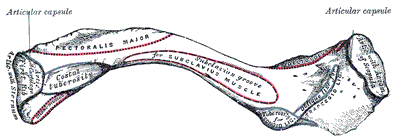
Ratbag of note: Erik von Sneidern
Erik runs the Disstonian Institute, a website full of arcane information about Disston saws. Henry Disston started making saws in 1840 and for the next hundred years Disston saws were the best in America.
Erik explains why he set up the Disstonian Institute: When I became interested in Disston handsaws just a few years ago, information was scattered here and there, lots of it was word of mouth, and there were no websites related to saw collecting. Online resources were limited to a couple of sites with reproduced catalog pages. It was a start, but I was not the only one looking for a place to see photos of old saws or to find the manufacturing date of a particular Disston saw. For the most part, I think I’ve accomplished it, so I hope it’s of use to you.
Well it was useful to me, Erik. How else would I have known that my D8 saws (a rip and a crosscut, both with DualGrip handles) were made before 1928?
Browsing by numbers: 10
10 things Google has found to be true includes such useful aphorisms as You can make money without doing evil and You can be serious without a suit.
![]()
Google hit parade
The annual summary of most popular searches on Google: What was hot and what was not in the year 2001? Our Year-End Google Zeitgeist feature provides a glimpse at what captivated the world over the past 12 months, based on the most popular search terms on the world’s most popular search engine. And the most popular search term for the year (and most frequently misspelled during September)?: Nostradamus!
Ratbag
Any person whose eccentricity I find appealing I am apt to call a ratbag. To me, it’s a word that implies fondness, an Australian idiom it seems. The British dictionaries either don’t know the word, or don’t see any positive connotation in it, and my old Websters doesn’t know the word at all. Here’s what I found:
Macquarie dictionary (1991):
“n. colloq. 1. a rascal; rogue. 2. a person of eccentric or nonconforming ideas or behaviour. 3. a person whose preoccupation with a particular theory or belief is seen as obsessive or discreditable: that Marxist ratbag. -ratbaggery, n. -ratbaggy, adj.”
Australian national dictionary (1988):
“A trouble-maker, a rogue; an eccentric; a person to whom some opprobrium attaches. Also attrib. … [examples cut] … Hence ratbaggery n. … [examples cut]”
Cobuild English dictionary (1995):
“In British English, if you call someone a ratbag, you are insulting them; an offensive word. Lying ratbags, that’s what they are.”
Pocket Oxford dictionary of current English (1996):
“n. slang obnoxious person.”
dictionary.com:
No entry.
Shorter Oxford English dictionary (1968):
No entry.
Webster’s new twentieth century dictionary (1960):
No entry.
Heritage Council
My three year appointment to the Queensland Heritage Council has just finished. The Minister for Environment has written to acknowledge my splendid contribution. I’m pleased he thinks so.
The value of history
After Christmas lunch I read a few chapters of Fred Smeijers’ Counterpunch (which I mentioned a few days back). I was taken with the way he answered the question ‘what is the value of history’:
A book like this one finds its place at a higher level: at the level of the question ‘what is the value of history?’ But that apparently abstract question also belongs to daily necessity. Because without such knowledge you float, without direction. History is there anyway, and it helps to know about it. In the long haul of human history, as in the short haul of our individual lives, discovering or remembering what happened in the early days can be essential for life in the present. This isn’t to say that there is a ready-made history there to be discovered. History changes constantly. New discoveries, new perspectives constantly change the shape of what is known. Facts, data, and the knowledge of them, is not what I mean by history. Rather, history is more like a puzzle that we try to complete, but which will always be unfinished. We look for patterns that make sense.
But why? What for? To let you—you the reader—compare now with then. In the colleges and universities, history is sometimes just the material of academic careers. But history is a human right and should be open to everyone. It is the way in which we represent ourselves, think and feel about ourselves, in which we create our cultures. History is not primarily a story about ‘where we come from’, about heritage or ancestry. It is more immediate than that. What history can do is help us to feel connected with the things that we do and are interested in. Forget the school history of great men and great events. For every imaginable subject or activity there is a history to be constructed. Do not believe that it need only be about high culture in the arts and sciences. Do not accept that it is limited by what can be read on paper in archives. It needs much less paperwork than the professional historians like to admit. It is quite possible that a young rock guitarist, reflecting on his own way of solving musical problems, can say much more interesting things about Paganini than a biographer who knows all the facts of the great musician’s life. History needs to become much more active, and so it needs to abandon its academic inhibitions. True history has no rules, no fixed angles or methods.
The history of typography is hard to get hold of, incomplete, unclear, wrong, just too old, or perhaps not old enough. You have to work for it. Maybe this book can help here. At least now it is clear to me that sitting and looking at punches is not enough. If you want to understand these things, then you have to make some yourself. I recommend to the theoreticians that they have a go at making some of these things of which they speak so knowledgeably.
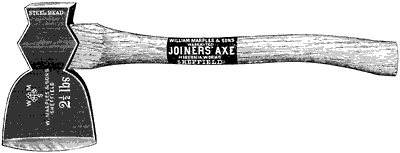
Point taken. I guess I should sharpen my broad axe and pitsaw, and do some hewing and sawing before I theorise any more about how slab buildings were made.
Recipe for boredom
See this piece by Laura Calder: Recipe for boredom: why must the modern cookbook be such a flavorless affair? She quotes from Elizabeth David, Sir Hugh Platt, George Augustus Sala and Hannah Wooley to show the literary delights of the recipe, now lost. Like Hannah Wooley’s recipe from The Compleat Gentlewoman, published in 1711:
A Cure for the Bite of a Mad Dog: Write in a piece of paper these words, Rebus, Rubus, Epitepscum; give it to the Party or Beast bitten, to eat in Bread. This never fails.
Not letterpress
To follow Thursday’s piece about hand made metal type, I show you this example of the excesses of digital type design. Using a computer to make type is just too easy. A font like Lushus might never have happened if it had required weeks of skilled work with files and counterpunches. Thanks anyway to Andy for pointing out this degenerate specimen.
Object of obsession: the infill plane
From about 1860, Thomas Norris & Son of London made the Rolls-Royce of woodworking planes, constructed with iron, steel, brass or gunmetal bottoms and sides, infilled with rosewood, ebony and other exotic timbers. High grade cabinet makers aspired to own these costly tools, known for their precision and performance. Discerning woodworkers and collectors still search for Norris planes, which have not been made since 1940.
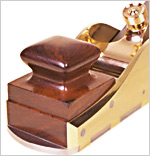
Luckily, you don’t have to search for one of these rarities. You can commission English plane maker Karl Holtey to make you a new one, even better than a Norris. On his website are descriptions and flattering pictures of ten different models based on classic designs. The workmanship looks superb.
Bench plane bodies are fabricated by double dovetailing the cheeks to the sole. This method differs from the wooden dovetail joint in that it is possible when using metal, to slope the tails in both directions. The tails are peened to fill the sockets, a process akin to riveting, but stronger. Using three plates of metal to construct the body allows the cheeks to be made from bronze whilst retaining a hardwearing steel sole. Unlike the planes of old with their steel cheeks, using different metals shows the dovetailing to advantage. Steel sided planes were prone to rust, particularly when marked by perspiration from the user’s hands; bronze cheeks do not rust. The sole is lapped to obtain a long lasting flatness far superior to anything obtainable by surface grinding.
A small chariot plane costs £1,880, a 22½ inch jointer is £4,600. Karl Holtey has recently introduced an innovative design of smoothing plane that takes advantage of modern materials and production methods to bring the price down to £1,650. On the other hand he offers to make a special 36½ inch jointer, for which the price would be in the region of £10,000. (For a rough conversion to Australian dollars, multiply those numbers by three). And I used to think Lie-Nielsen planes were expensive.
The Fritz collection
In 1993 in a bric-a-brac store the Viennese artist Oliver Croy discovered somebody’s oeuvre packed away in rubbish bags: 387 model buildings and a collection of ca. 3,000 slides. He bought them all for about 500 Euro. The slides document the period from 1965 to 1975, often showing an obese man, a bald-headed person of regular habits, orderly dressed, wearing old fashioned glasses. The slides are also showing several travels together with his female collegue and his wife, on the trip with their VW beetle. The destinations were, with few exceptions, the Austrian Alps.
See the article at designboom.com.
Letterpress
I’m reading Counterpunch: making type in the sixteenth century, designing typefaces now by Fred Smeijers. Fred is a digital type designer who has gone back to the roots of printed type. He has studied early type-makers’ tools in museums, and taught himself to make type punches used for making moulds for casting type for hand setting. A fascinating book.
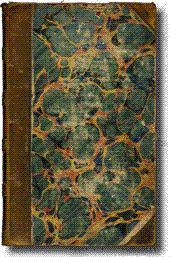
I don’t have anything printed in the period Fred writes about, but I was reminded to look at a book I do have. It was printed in London in 1770, the second volume of Sermons on several subjects by Thomas Secker LL.D., Late Lord Archbishop of Canterbury, published from the original Manuscripts, By Beilby Porteus D.D. and George Stinton D.D., His Grace’s Chaplains. I am not drawn to its boring content, but I like to see and feel and read a volume made when books were such special possessions.
His Grace’s words are printed in roman and italic type with dark brown ink on cream laid paper. You can see the fine corduroy watermark made by the wires of the paper mould. The corners and spine are covered with brown leather (calf?), with red leather (morocco?) spine labels for the gold blocked title and volume number. The boards are covered with marbled paper, and the edges of the book are marbled to match. Perhaps all these details were discussed between the book binder and the book owner, in a time when book sellers supplied books unbound. Or maybe the book was just sent to the binder with a note to bind this to match the others in the Rev. Mr. So-and-so’s library. For me this book is a microcosm of skilled hand work, in paper making, type setting, printing, binding, paper marbling and gold blocking. Turning its pages is a ticket back a couple of hundred years from the present.
Fire!
From The New York Times a sad report: A wing of the Cathedral Church of St John the Divine erupted in flames yesterday morning…
For a happier view, see these pictures of stone carvers at work on the west doorway.
Omit unnecessary words
An unusual weblog, Textism looks good and reads well. Such economy. Just three words today—sometimes it snows—linked to wordless photographs. It’s been snowing in Pompignan. I want to go there.
Planespotting
If you pick up Stanley planes in junk shops and wonder how old they are, I have a suggestion. Print out this web page and carry it with you. It’s a dichotomous key: Answer a few yes/no questions about the tool to discover its date. You might find a Type 1 (1867-1869), worth a lot of money to an obsessed Stanley collector.

I’m not obsessed, but I did check the six bench planes in my toolbox. Two were Type 14 (1929-30), three were Type 15 (1931-32). That’s odd, I would have expected a greater spread of dates.
Le Corbusier
I was reminded of my old interest in the architect Le Corbusier by the website of the Fondation Le Corbusier.
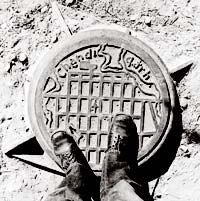
Virtual museum: HistoryWired
New from the Smithsonian Institution is HistoryWired: a few of our favourite things, a showcase of objects and stories. You can navigate the collection of objects with a very clever map that shows thematic connections between them. The site design builds on the experimental Revealing things website I wrote about in the Ironic column.
Design interact has this article about the HistoryWired site—the way the different skills of the interface designers and the curators were applied makes good reading.
Object of obsession: the clutch pencil
Dennis B Smith runs a website he calls leadholder.com, subtitled the online drafting pencil museum. This seriously obsessive site catalogues all known makes and models of clutch pencils (which Americans call leadholders). The site is very nicely designed and written.
![]()
Browsing by numbers: 5
Five Things You Can Do To Fight Entropy Now is a short essay by Romana Machado. I dislike All Those Unnecessary Capitals, but I am interested in entropy because it figures in my life—a life shared with two young children who are powerful entropic agents.
I don’t support all of Romana’s recommendations (cryogenic storage of dead bodies is especially weird).
The wrong tie
Why can’t I dance like this bloke? Must be wearing the wrong tie.
US judge pulls the plug on the internet
A Washington Post article gives an update on court action over US government failure to properly deal with American Aborigines’ trust funds:
Responding to a court order, the Interior Department has cut itself off from the Internet, crippling the ability of Interior employees to communicate by e-mail and blocking access to information gathered by the department that is routinely used by other agencies and the public.
The plaintiffs in the case have their own website.
architecture.com.au
The RAIA has a new website. It presents a clean and appealing look, to go with a new database-driven back end. The old Australian Directory of Architects and Building Designers find an architect database is there with a fresh face. People can enter their location and the sort of services they need — the system displays a random list of architects and their details.
This all works nicely, but there’s a hitch: it seems most architects claim to do all sorts of work. So if you go looking for a conservation specialist, you’ll be lucky to find my name among the jacks-of-all-trades.
Memorialising the World Trade Centre
Metropolis Magazine has an interview with Yale University architectural historian and critic Vincent Scully about the destruction of the WTC. In the past, Scully was no fan of the twin towers.
As you know, very few of us really liked the World Trade towers. They seemed too big, dumb, and inarticulate. When they got hit, all the associations changed. All of a sudden, instead of looking inordinately tall, they looked heartbreaking. Now I love them. It’s a little like how our associations changed regarding New York mayor Rudy Giuliani. I have never been a big fan of Giuliani, and now I love Giuliani.
The article is worth reading for its observations about memorials to great tragedies—Maya Ying Lin’s Vietnam Memorial in Washington DC gets a mention.
Brand new BMW for $495
That’s US dollars, about $1,000 Australian. A bargain? Well no, it’s not a car, just a skate board called the Street Carver. Ask Santa, he just might… Sure, and pigs might fly.
Look back in Ingres
This piece in the New York Times is about a symposium featuring painter David Hockney and some art history scholars. Hockney reckoned the Old Masters used more lenses, mirrors and other optical aids than had been thought. Not everyone agreed — the debate sounds like fun.
I think Susan Sontag produced the best quip. To say that there were no great painters before optical devices, she said, is like saying there were no great lovers before Viagra. (Thanks to Arts & Letters for the link).
L’Encyclopédie
Yesterday’s score from Archives Fine Books in Brisbane: A Diderot pictorial encyclopedia of trades and industries: 485 plates selected from “L’Encyclopédie” of Denis Diderot (2 vols, Dover, 1959).
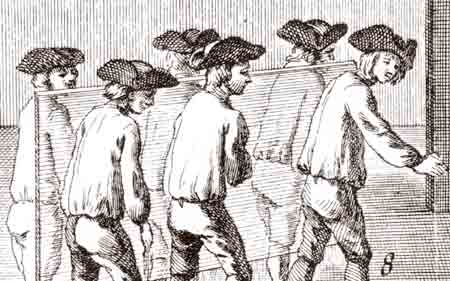
This snapshot of eighteenth century technology will fill a hole in my library.
World AIDS Day 2001
I’m prompted by the Link and think campaign to mention William Yang’s wonderful performance piece, Sadness. In this show he stands in front of the audience telling his story and working a set of slide projectors. With his quiet voice, his deadpan photographs, the varied pace of the story and the way he engages us with it, this goes way beyond the old living room slide show.
![]()
Sadness is an interwoven narrative about William Yang’s personal and family history, and about a generation of his friends in Sydney affected by AIDS. Here’s an interview with him.
News to put you off your pudding
Last night’s closing dinner for the 20th century heritage conference was held at the newly opened National Wine Centre of Australia. This bold new building seemed a fitting venue.
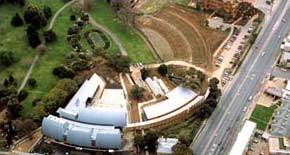
At least, it seemed fitting until after the main course. Then Dr Jane Lomax-Smith, ex Lord Mayor of Adelaide and our guest speaker, told us about the campaign to stop this building site being cut out of Adelaide’s parkland. Gulp! Even by coming here for dinner, I felt we were lending respectability to a bad idea.
